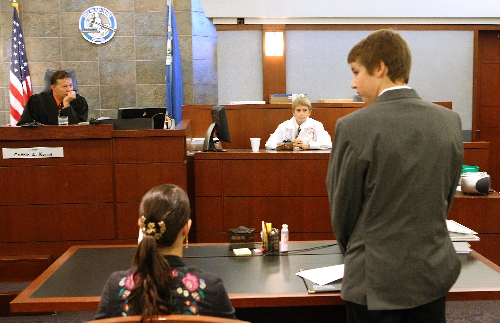Students’ mock trial demonstrates knowledge about spread of disease

According to pop culture, what happens in Las Vegas is supposed to stay here. With regard to disease, what happens here can spread virtually everywhere.
The city is an international hub of 2 million people with a skinny four-mile long strip of road that entertains upwards of 37 million people annually.
Cram a large amount of people, some of whom are sick, into a confined area and disease will spread. That’s what middle school students clad in suits and ties argued Friday during a mock trial in Las Vegas Municipal Court.
The participants squabbled over a misdiagnosis, a potential epidemic and whether a fictitious hospital was responsible for the death of a fake patient as part of a summer program at the Alexander Dawson Foundation Center for Excellence in Teaching & Learning.
At 18 minutes and change, it was the fastest trial in Clark County’s history with no verdict.
Opening statements were made, witnesses were called to the stand, sworn in, and objections were sustained in Judge Cedric Kerns’ courtroom.
All of this was to demonstrate what the students had learned so far in the six-week enrichment program regarding the math and science behind an epidemic and how a disease can quickly wreak havoc on a community.
"You’ve got a lot of people coming in and jamming into a little small space," said Frank Wang, a teaching fellow at the center. "The average person spends three to five days, just enough time for a disease to incubate itself and spread. What makes Las Vegas unique is I don’t think you can find any other city in the world where the ratio of the visitors to the population is so great."
Wang taught his students how to figure out the reproduction rate of a disease, which is how quickly it can spread among people. The rate also determines how many vaccines are needed.
For example, measles has a reproduction rate of 12 — meaning one person can infect 12, Wang said. The rate is used in formula that helps health officials determine the number of people needed to be vaccinated.
Thirteen-year-old Jordan Goyeau played a health department official explaining to the court about state laws for isolating patients.
Goyeau said she learned about the domino effect, in which one person infects another person who continues the spread of the disease.
"We’re learning about disease and how one person can spread a disease throughout the world," she said. "We also learned about taking precautions, like washing your hands, and how important that is."
Another student, Andrew Poggione, played a hospital doctor who misdiagnosed the patient with tuberculosis when he actually had bacterial pneumonia. The patient eventually died.
Poggione, 13, said he studied more about the math side of an epidemic and how the reproduction rate determines how many vaccinations are needed.
"We talked a lot about viruses and washing your hands, and we looked at how health department officials look at restaurants," he said. "We talked about how they’re cleaned and how they have restrictions."
Contact Kristi Jourdan at kjourdan@reviewjournal.com or 702-383-0279.